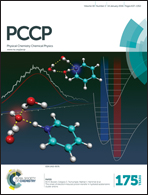Tuning excitability by alloying: the Rh(111)/Ni/H2 + O2 system
Abstract
The dynamic behavior of the O2 + H2 reaction on a Rh(111) surface alloyed with Ni has been studied in the 10−5 mbar range using photoemission electron microscopy (PEEM) as a spatial resolving method. For T = 773 K and p(O2) = 5 × 10−5 mbar the bifurcation diagram has been mapped out as a function of the Ni coverage in a range of 0 ML ≤ ΘNi ≥ 1.3 ML. A critical Ni coverage of ΘNi,crit = 0.13 monolayers (ML) is required for excitability. In the excitable parameter range pulse trains and irregular chemical wave patterns are found. Whereas the propagation speed of the pulses exhibits no clear-cut dependence on the Ni coverage, the frequency of the local PEEM intensity oscillations increases linearly with Ni coverage in the range from ΘNi = 0.13 ML to ΘNi = 1.3 ML.


 Please wait while we load your content...
Please wait while we load your content...